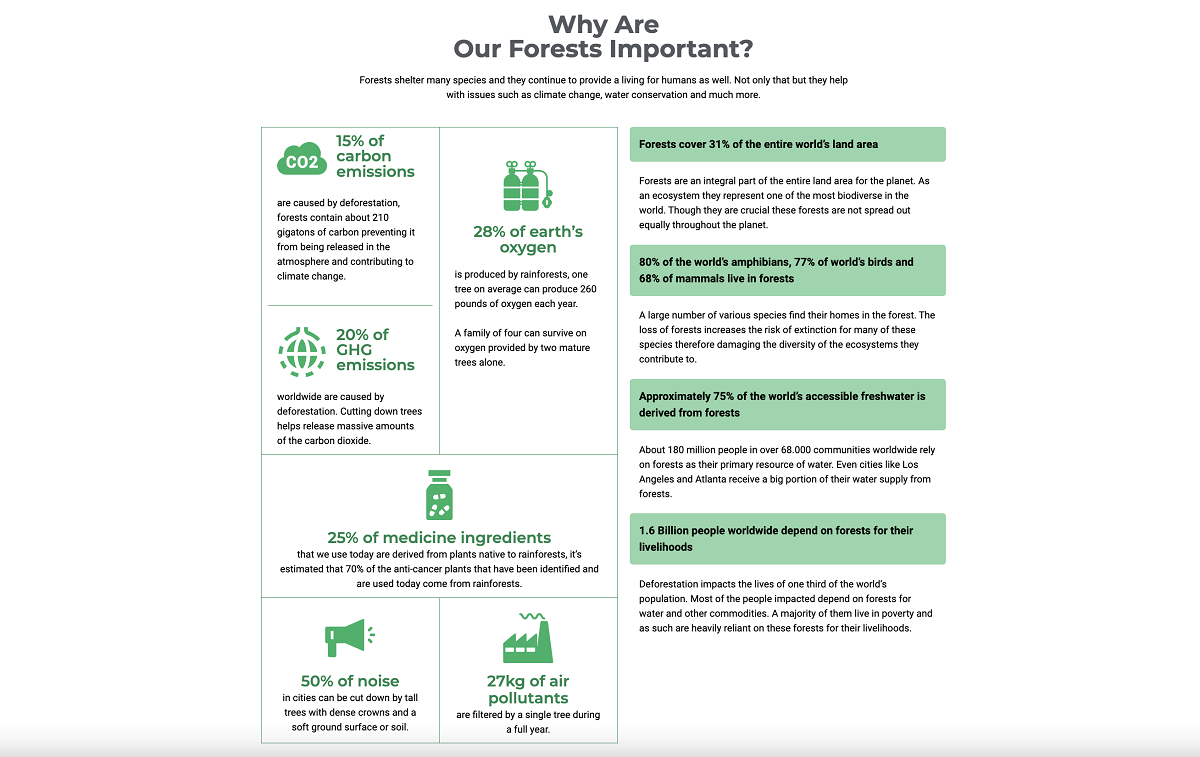Forests are life. Not only for flora and fauna – 80% of terrestrial animals, plants and insects live in them, according to the World Wildlife Fund (WWF) – but also for people, more than 2.5 billion of whom depend on forests and forest products for food, water or work, according to the Food and Agriculture Organization of the United Nations (FAO).
Trees also are one of the last lines of defense in the fight against global climate change. We must find solutions to deforestation in order to support a vital part of our climate fight.
“Trees are without a doubt the best carbon capture technology in the world. When they perform photosynthesis, they pull carbon dioxide out of the air, bind it up in sugar and release oxygen,” forestry educators Melissa Kreye and Calvin Norman explained in an article for Penn State Extension, the extension program at The Pennsylvania State University.
Unfortunately, trees are disappearing at record rates. Illegal logging and land grabbing in areas of the rainforest threaten long-standing untouched forests. In a February 2023 report, satellite images show a loss of 30,000 football fields worth of destruction in a single month in Brazil — the worst February for deforestation on record.
Although forests cover 31% of the planet, WWF says the tropics alone are losing nearly 30 soccer fields’ worth of trees every single minute. Worldwide between 2002-2019, an average of 8.3 million acres of forest – an area larger than Belgium – disappear every year, according to Conservation International. At that rate, the British newspaper The Guardian conjectures that rainforests may vanish altogether within the next century.
According to recent statistics compiled by Lawnstarter for The State of Forests and Forestry, the problem is accelerating in certain parts of the world. Every year 10 million hectares of forest are lost, 80,000 acres of forest are lost every day, 15 billion trees are cut down each year, and 50,000 species disappear.
In late February 2023, the Department of Agriculture announced a nearly $10 million investment in forest nursery and native seed partnerships. Funding for these reforestation efforts comes from the Biden-Harris Bipartisan Infrastructure Law. These investments complement the recently announced $35 million investment in Forest Service nurseries in support of the National Forest System Reforestation Strategy.
If humanity wants to slow rising temperatures, it must find solutions to deforestation, which accounts for up to 15% of global carbon emissions, Reuters reports.
To do so, conservationists are relying on something even more powerful than bulldozers: cloud computing, which they’re utilizing to quantify, combat and counteract deforestation around the world.
How Technology Can Prevent Deforestation
Tech-based solutions like drone photography, remote sensors and satellite imagery help protect the priceless forests that are still standing. By analyzing it, conservationists can monitor land changes over time, thereby identifying deforestation so they can intervene in order to stop it.
There’s just one problem: The proliferation of satellites has created too much of a good thing. NASA satellites, for example, have captured one image per season of every place on Earth for the past 49 years. The result is more than 50 trillion pixels of data.
“Entities looking to track and prevent deforestation are faced with vast and growing amounts of unstructured data that are practically impossible to manage,” IBM reported in a 2021 case study about the use of technology by conservationists.
To turn data volume from a handicap into an upper hand, companies like IBM are using cloud-based artificial intelligence and machine learning platforms to process satellite imagery quickly and efficiently.
“Filtering large amounts of data can be slow, labor-intensive and expensive,” Adriana Erthal Abdenur, co-founder and executive director of Brazilian climate institute Plataforma CIPÓ, wrote in an article for the Global Conservatory.
“Some of the most promising innovations for enhancing the monitoring of forests involve artificial intelligence and associated technologies, such as deep learning and machine learning. AI can enhance the accuracy of forest monitoring, can help make forest data more reliable, can speed the data analysis process exponentially and can build up local capacity for forest monitoring. Some of the innovations entail attempts to predict where deforestation will occur.”
An early AI innovator in the area of forest management was Google, which in 2013 published a groundbreaking map illustrating how Earth’s forests had changed between 2000 and 2013. Produced in partnership with geographers at the University of Maryland, it was created using machine learning algorithms that analyzed 700,000 publicly available images from NASA’s Landsat series of Earth-observing satellites. On a single computer, the analysis would have taken 15 years. Because the work was spread across 10,000 different computers using the cloud, however, it took only a few days.
“In the past, I used to bring data to my computer and analyze it … Now it’s impossible to bring all the data to my computer,” Landsat scientist Jeff Masek told the NASA Earth Observatory in a 2015 article.
“With distributed and cloud computing] we can implement our algorithms where the data live. It’s a different way of mining the Landsat archive.”
The online forest monitoring platform Global Forest Watch builds on Google’s and NASA’s work by using software to analyze satellite imagery and detect when precious trees have disappeared.
“We can actually see these little patches that indicate where there’s been removal of a single tree,” Mikaela Weisse, who helps run the site, told NPR.
“If we can detect deforestation and other changes as soon as they’re happening, then there’s the possibility to send in law enforcement ... to stop it before it goes further.”
For years, scientists have used remote sensing to acquire data and study physical, chemical and biological impacts on the environment in order to find solutions to problems like deforestation. Now, they can tap into on-demand networks of cloud-connected sensors—including satellites in space, drones in the air and field-based wireless sensors on the ground—that collect environmental observations and measurements in real time.
Sustainable Supply Chains to Protect Against Deforestation
Satellite imagery and machine learning can empower not only conservationists but also corporations.
Again, Google is leading the way. In September 2020, it announced a partnership with consumer packaged goods company Unilever to help end deforestation within its enormous supply chain.
“By combining the power of cloud computing with Google Earth’s ability to map the planet by satellite imagery, we’ll be able to store and make sense of huge amounts of complex data, and gain insights into any impact on local environments and communities,” explained Unilever, which owns brands like Axe, Ben & Jerry’s and Dove.
“Not only will this lead to greater accountability in our supply chain, it will also help us to better detect deforestation and prioritize any areas of forests or habitats in need of urgent protection.”
Unilever is hoping to find solutions to deforestation within its supply chain by 2023 The company is using lessons from this process to help other enterprises do the same within their own logistics networks.
“This collaboration with Google Cloud will take us to the next level in sustainable sourcing,” said Dave Ingram, Unilever’s chief procurement officer.
“We will now be able to process and combine complex sets of data like never before. The combination of these sustainability insights with our commercial sourcing information is a significant step-change in transparency, which is crucial to better protect and regenerate nature.”
Adds Rob Enslin, president of cloud sales at Google, “Together, we’re demonstrating how technology can be a powerful tool in aiding businesses who strive to protect the Earth’s resources. It will require collective action to drive meaningful change, and we are committed to doing our part.”
Using Drones to Reverse Deforestation
Environmentalists are tackling deforestation with cloud-based data of all types at their fingertips – not just satellite imagery. Rainforest Connection, for example, is addressing illegal deforestation in real time with an acoustic monitoring system that uses cell phones strategically placed throughout the rainforest to detect the sound of chainsaws.
And then there are drones, which technologists are harnessing to reverse deforestation and mitigate its harmful impacts.
Take Dendra Systems, which is arming drones with “seed missiles” in an effort to plant trees and restore greenery to regions leveled by deforestation. In Myanmar, its flying robots provide air support in an otherwise back-breaking manual effort to repopulate the Earth with essential flora.
“The drones first fly over an area to map it, collecting data about the topography and soil condition that can be combined with satellite data and analyzed to determine the best locations to plant each seed. Then the drone fires biodegradable pods – filled with a germinated seed and nutrients – into the ground,” Fast Company reported. “Two operators working with 10 drones can theoretically plant 400,000 trees in a day.”
These tree-planting drones are more time- and cost-effective than human labor and can access hard-to-reach areas with limited effort and safety risks. By leveraging cloud and edge computing, which are easily scalable, Dendra and its nonprofit partners hope to plant millions of more trees in the coming years.
“By now, we have all recognized the urgency of climate change and the impact of global land degradation – from frequent flooding, costly wildfires, deforestation and the loss of biodiversity devastating ecosystems across the world. We need hands across all industries to fight back if we are going to make a dent on climate change and it starts with restoring our degraded ecosystems and lands,” Dendra CEO Susan Graham said in a 2020 press release.
Between monitoring deforestation and mitigating it, cloud-based technologies might be the key to success.
“AI can help prevent at least some of the environmental disasters we are currently witnessing,” the Global Conservatory asserts.
It can do so by ensuring that when a tree falls in the forest, people can not only hear it, but also do something about it.
This is an updated version of the original article published on December 9, 2021.
Chase Guttman is a technology and travel writer. He’s also an award-winning travel photographer, drone cinematographer, author, lecturer and instructor. His book, The Handbook of Drone Photography, was one of the first written on the topic and received critical acclaim. Find him at chaseguttman.com or @chaseguttman.
© 2023 Nutanix, Inc. All rights reserved. For additional legal information, please go here.










